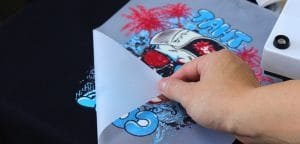Hot Peel vs. Cold Peel: Understanding the Difference in DTF Transfers
You’ve set up your heat press, aligned your DTF transfer perfectly, and pressed it onto the garment. The timer goes off… now what? Do you rip the film off immediately, or do you wait? This single step is the crucial difference between the two main types of DTF transfers: Hot Peel and Cold Peel.
Understanding which type you have and the proper technique for each is essential for a perfect, long-lasting print. Let’s peel back the layers on this important topic.

The timing of the peel changes everything from workflow to the final finish.
What Defines Hot Peel vs. Cold Peel?
Hot Peel DTF
Hot peel film is designed for speed. You must peel the carrier film away immediately after the heat press opens, while the garment and transfer are still very hot. The adhesive is formulated to release cleanly at high temperatures.
Cold Peel DTF
Cold peel film is designed for reliability. You must let the garment and transfer cool down completely before attempting to peel the film. This allows the adhesive to fully bond with the fabric as it cools, ensuring all details transfer perfectly. This can take anywhere from 30 seconds to several minutes.
Comparison Chart: Which is Right For You?
| Feature | Hot Peel | Cold Peel |
|---|---|---|
| Peel Process | Peel immediately while hot. | Wait until completely cool to peel. |
| Finish & Feel | Softer, matte finish that feels “in” the fabric. | Shinier, satin/gloss finish. Can feel stiffer initially. |
| Speed | Very Fast. Ideal for high-volume production. | Slow. The mandatory cooling time adds up. |
| Ease of Use | Requires confidence. Can be tricky for beginners. | Very Forgiving. Great for complex or fine-line designs. |
| Best For… | Speedy production, achieving a soft “screen print” feel. | Beginners, highly detailed designs, and a vibrant, glossy look. |
Pro Tip: The Second Press
For maximum durability and an improved feel, we recommend a “second press” for both types of transfers. After you peel the film, cover the design with a Teflon or parchment paper sheet and press it again for 5-7 seconds. This locks the design into the fabric fibers and can help soften the feel of a cold peel transfer.
The Verdict
There is no “better” option—only the right option for your specific job and preference. Hot peel prioritizes speed and a matte finish, while cold peel prioritizes ease of use and a glossy finish. Both produce fantastic, durable results when applied correctly.
Always check the product description for the transfers you buy to ensure you’re using the correct peeling method recommended by the manufacturer.
Know Your Peel, Get Perfect Results
We provide clear instructions with all our DTF transfers so you know exactly how to get the best results. Ready to press with confidence?
